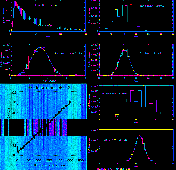
 |
Documentation > SXT Observation Notes > this page |
Image name: DARKFRAME_STATISTICS.png (click image to enlarge)
Image size: 152.096 KB (1024x986)
Date submitted: 15-Nov-1997

STATISTICAL PROPERTIES OF SXT DARKFRAMES The uncertainties produced by sxt_prep are only the decompression errors. The program sxt_dn_unc only provides an estimate of the counting statistics in the fully-corrected x-ray image. We have no software that provides an estimate of the error introduced by darkframe statistics nor the effect of straylight subtraction. As a start on understanding some of these sources of uncertainty we have been ignoring I've taken a look at the half-resolution dark frames from 24-JUL-96. The read noise is from the DPE=2 darkframe and the dark current is from the difference of the DPE=30 and DPE=2 darkframes. For the dark current (upper LH panel) I find that the statistics of the dark current are highly non-Poissonian. In fact, as illustrated in the lower plot of the panel, the dark current statistics are fairly close to a log-normal distribution. This is evidenced by the reasonable fit of a Gaussian to the histogram of the logarithm of the dark current signals from this dark image. I haven't a clue as to how to formally treat this source of error in SXT analysis. The read noise statistics are somewhat more tractable. The figure in the lower left illustrates the DPE=2 darkframe with the average slope (illustrated in the overlaid plot) removed. The histogram of the _unflattened_ darkframe is shown in the uppermost RH plot. In the next plot down I show the histogram of _flattened_ (i.e, readout slope removed) darkframe with the average value added back in. This distribution is quite well fit by a Gaussian. The standard deviation is quite small, indicating that the read noise approximates a DC pedestal with only a small statistical component. In the 2 lower RH plots I concentrate on 144 columns which have nearly the same total read noise signal. These columns are identified in the middle section of the darkframe image. This selection further narrows the distribution as shown in the plots. As the darkframe subtraction is done column by column, i.e., with pixel match between the x-ray picture and the darkframe, this narrower distribution is appropriate for use as the statistical error coming from the read noise. I am still puzzling over how to propagate the straylight error. The SFCs are highly smoothed in order to minimize any contribution to the statistical error of the corrected x-ray image. However, it is clear that straylight subtraction is far from perfect. Somehow we need to figure a way to estimate this uncertainty if the error bars placed on SXT temperatures and emission measures are to be valid. L. Acton 15-Nov-97